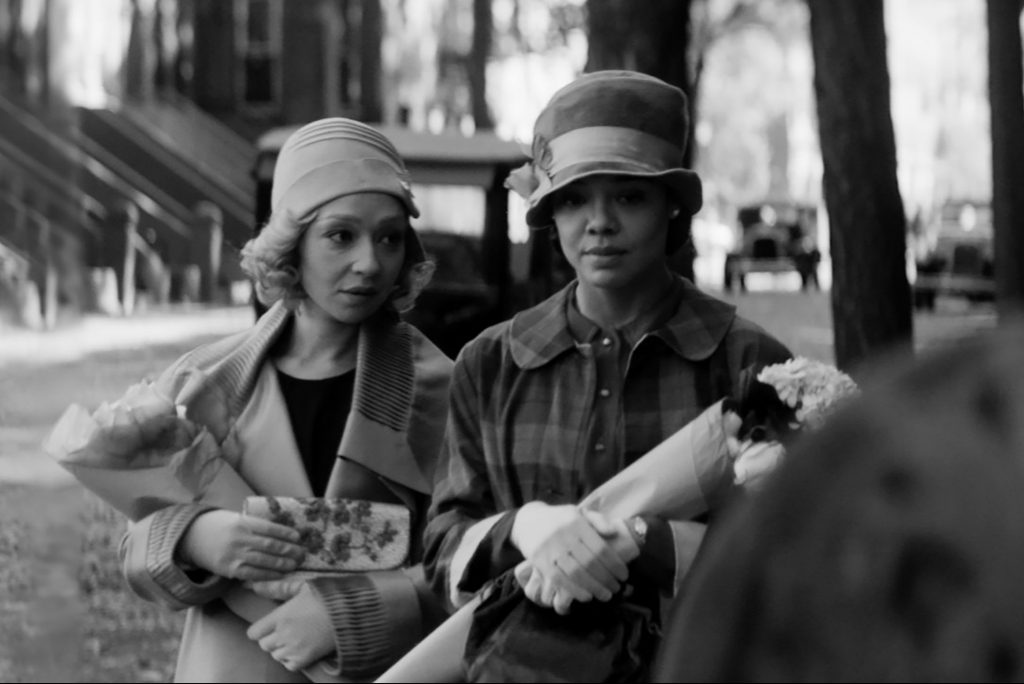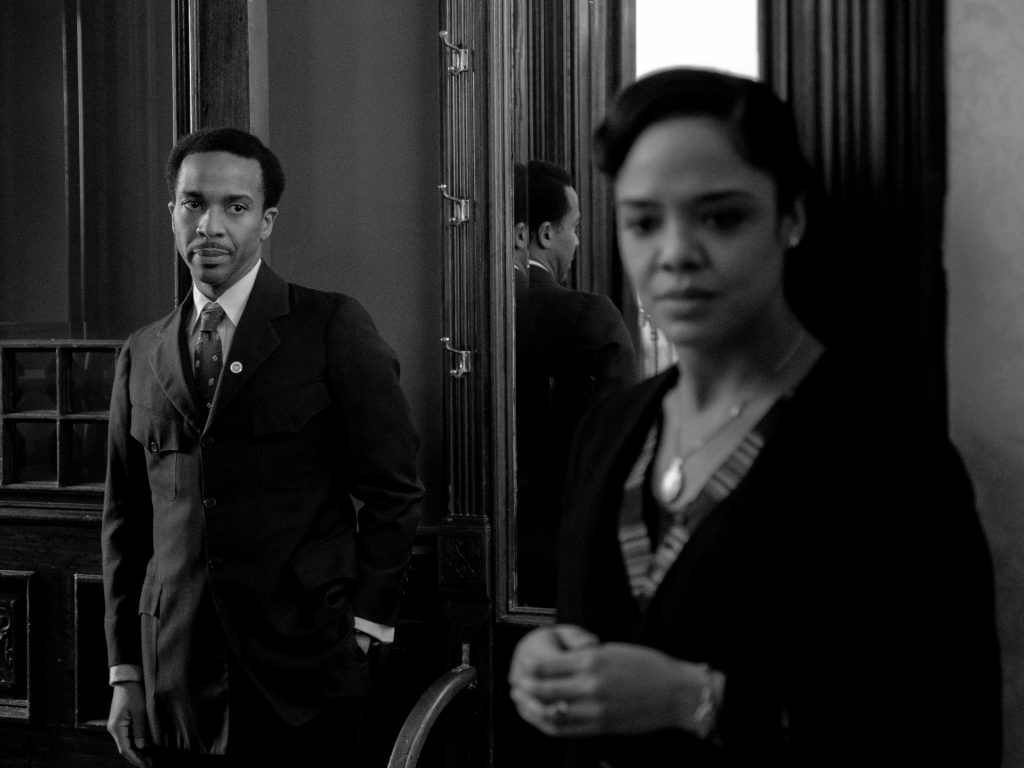Review: “Passing” explores identities of race, sexuality with thought and grace
Review: "Passing" explores race, sexuality with grace and thought

Based on the novella by Nella Larsen, Passing follows the story of two Black women who reunite after years of living separate lives. Irene (Tessa Thompson) has a husband and two kids, and they live in a wealthy Black neighborhood in New York City. Clare (Ruth Negga) is passing for white and is married to a white man. The film examines the complexity of being a woman of color during the 1920s.
Ellen Mintzer and Riley Utley saw Passing at The New York Film Festival and wrote about their thoughts on this complex film.
Passing offers a thought-provoking exploration of Blackness, femininity, and sexuality in the 1920s
By Riley Utley
The first thing you hear in the film Passing is quick, nervous breathing. Irene (Tessa Thompson) walks down the streets of New York City, in a snazzy dress with packages in elegant wrapping. She walks hesitantly, trying to make herself as small as possible as not to be harassed.
The film, based on the 1929 novella by Nella Larsen, paints a beautifully complex portrait of two Black women and how the intersectionality of race and sexuality has impacted their lives and psyches, in a time where they were not allowed to voice their struggles without backlash. Following Irene and Clare (Ruth Negga), the film shows the differences in their lives and their marriages. Both women are Black, and Irene is married to a Black man, but Clare is passing as a white woman and is married to an outwardly racist white man — who does not know her true racial identity. The tension in all of this is paramount to the film, as it’s obvious to the viewer but never verbalized. Instead, it’s all depicted through subtle actions.
Even the smallest gesture like Irene tightly grasping her teapot in moments of tension, hiding her eyes under her hat when she met her friend Clare’s white husband and quickly grabbing at Clare’s hand in a moment of passion. Irene shows emotion through her eyes as she takes the audience into her soul and begs them to figure out what she’s not saying.
When Irene is deep in thought or admiring Clare, a little 1920s upbeat, whimsical jazz piano riff plays. This brilliant composition by Dev Hynes creates a motif that lets the audience into Irene’s head. It’s through this music that the subtext points out that she loves Clare without her ever saying the words. Through the technical choices in the film like the music and composition Hall was able to emphasize her message of the film that everyone is passing for something.
The decision to film in black and white also created a color scheme that shows the shades of gray between right and wrong, acceptable and unacceptable. The black and white put a spotlight on how things are never clear-cut. Intersections impact everything, and everything is a different shade.
The film examines what it means to be a queer Black woman during a time when all three of those things were not widely accepted in American culture, and it begs the audience to consider what they are passing for.

Passing is a work of exquisite subtlety and complexity
By Ellen Mintzer
Two women lock eyes across a room. In their eyes, there’s fear, wonder, and most of all, a sense of joyful recognition. This is the reunion of Irene and Clare, former classmates who haven’t seen each other in years. In their time apart, the two women have built similar lives for themselves — husbands, children — yet they now live worlds apart.
Irene and Clare are the center of Passing, a film adapted by Rebecca Hall from Nella Larsen’s celebrated Harlem renaissance novella about race and identity. The film, Hall’s directorial debut, is in black and white, a brilliant aesthetic choice that reflects the film’s preoccupation with Blackness and whiteness. Its two stars, Tessa Thompson as Irene and Ruth Negga as Clare, anchor the film’s sensitive exploration of race with their delicately layered performances.
Although both women are Black, Clare has chosen to “pass,” or live as a white person, a common practice in 1920s America among light-skinned Black folks. Clare made this choice in pursuit of safety, yet she yearns for her old life and must tolerate her white husband John’s casual racism and live in fear of discovery. John, a nasty cad played with gusto by Alexander Skarsgard, flatly tells Irene that he hates “negroes”. He’s mistaken her for white, and the scene is a queasy revelation of the way some white people talk about Black people when they do not realize one is present, even in the would-be haven of the North. Thompson’s depiction of Irene’s fear, which she is forced to mask under barely mustered amusement, is masterful; Negga skillfully renders Clare’s tolerance of John’s hatefulness while flashing Irene a warning. The actresses’ performances, especially juxtaposed against Skarsgard’s abrasiveness, are wondrously subtle, communicating so much with only their expressive faces. Despite the figurative distance between them, Clare and Irene have a shared language.
Still, neither woman can quite figure the other out — Clare wonders why Irene has never tried passing, while Irene doesn’t understand how Clare can live with such danger and bigotry. Hall’s script does great justice to Larsen’s original text, deftly exploring complex issues of identity with layers of meaning and a sense of weary longing underlying every word. Irene muses to her husband, “Do you think they’re satisfied being white?” He replies, “Who’s satisfied being anything?” Clare confesses, her wistfulness almost too much to bear, “You can’t know that, in this pale life of mine, how I long for the light of my old one.” The film confronts us with prickly questions that refuse easy answers: Is sacrificing your community worth an illusion of safety? What is happiness, and who is able to possess it?
The friendship between Clare and Irene blooms, marked by girlish delight in one another’s company, yet remains fraught with tension, an ambivalence that Thompson plays particularly well. Clare views her visits to Irene’s home in Harlem as an exultant homecoming. Irene views the visits, to some degree, as a form of tourism. This is the Harlem of Langston Hughes’ essay “When the Negro was In Vogue,” when affluent white people flooded cabarets and jazz clubs to gawk at Black culture. In the film, a scene of Black Harlemites dancing with abandon to euphoric horns is a dynamic blur of energy and joy; the tension expressed in the very lines of Irene’s body relaxes at last. And yet she simmers with resentment toward what she views as Clare’s voyeurism. Is Clare returning home to her people, or is she rubbernecking in Harlem like so many white folks? Again, the film offers no easy answers.
The film’s greatest fault is that the story loses its footing at the beginning of the third act. There’s a lull of uncertainty in the script, a lack of focus that’s surprising in an otherwise surefooted narrative. But the story regains its balance soon enough, building to a shocking climax that’s as ambiguous as it is tragic.
The film begins in soft focus, with muffled voices, and a blurred New York street that gradually sharpens into a cacophony. This soft-focus returns when Irene first lays eyes on Clare, and again when Irene is processing the aftermath of her encounter with John. She disappears into a reverie, the world around her fading. This technique reflects the blurring of racial boundaries in the film and the ambivalent relationship, the open questions of happiness and safety, that each woman has with the life she’s chosen. Hall’s cinematic choices vividly parallel the film’s themes, creating a world of black and white and many shades of gray.






